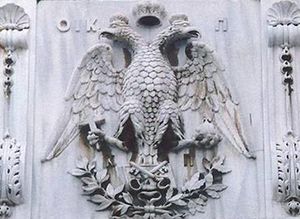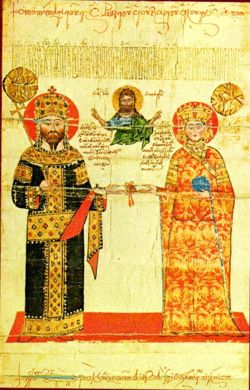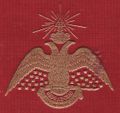
Two-headed eagle emblem of the
Byzantine Empire. Relief from the Ecumenical
Patriarchate of Constantinople (Istanbul)
The double headed eagle is a common symbol in
heraldry and vexillology. Several Eastern European nations
use this symbol today, having adopted this symbol from the
Byzantine Empire. In Byzantine heraldry, the heads represent
the dual sovereignty of the Emperor (secular and religious)
and/or dominance of the Roman Emperors over both East and
West. The Russian tsars adopted the symbol both to position
themselves as successors to the Byzantine state and to
likewise symbolize their dominion over the west (Europe) and
the east (Asia).
The two-headed eagle appears on the
coat of arms of the following countries:
- Albania
Austria-Hungary (historical)
Bosnia and Herzegovina:
Republika Srpska
Byzantine Empire (historical)
Russian Federation
Russian Empire (historical)
Serbia and Montenegro (historical)
Serbia
Montenegro
Pre-WWII Yugoslavia (historical)
It also appears on the following flags:
- Flag of Albania
Flag of Montenegro
Flag of Serbia
the flag of the Ecumenical Patriarchate of
Constantinople.
the flag of Mount Athos
Origins
Double headed eagles have been present in imagery for
many centuries. A representation of a two-headed woman
dating from
6000 BC was discovered in Çatalhöyük (Turkey) one of the
oldest cities in the world. Therefore, the apparition of the
two-headed eagle is very old, because it can be found in
archeologic remains of the Hittite civilization dating from
a period that goes between the 20th century BC and the 13th
century BC.
First, cylindric seals discovered in Bogazkoy, nowday
(Turkey), an old Hittite capital, represents clearly a
two-headed eagle with spread wings. The esthetic of this
symmetric position explains in part the birth of this
religious figure. It probably dates from the 18th century
BC, and was used in a tradesman background.
This symbol can also be seen in the same region in two
monumental realisations : in Alacahöyük (around 1400 BC) and
in Yazilikaya (Turkey). (before 1250 BC). Here the context
looks different and totally religious. The eagle becomes
divinity's symbol. The two-headed eagle slowly disappears
during the last Hittite period, from the 9th century BC to
the 7th century BC and totally disappears after the end of
the empire.
Byzantine Empire

Example of the use of the double-headed eagle on
imperial vestments, from a chrysobull of
Alexios III of Trebizond, mid-14th century.

A double-headed eagle portrayed in a
stained glass window inside St. Nicholas Greek
Orthodox Cathedral in Tarpon Springs, Florida.
Constantinople was the successor of Rome, and the Byzantines
continued the use of the old imperial 'single-headed' eagle
motif. Although the roots of the transformation to
double-headed are almost certainly connected with old
depictions in Asia Minor, the details of its adoption are
uncertain. Beyond any doubt, it was used in the wider area
during the first centuries AD and certainly before the 10th
century AD, as it appears in Persian and Armenian art.
According to the most prevalent theory, the imperial Roman
single-headed eagle was modified to double-headed by emperor
Isaakios Komnenos being influenced from local traditions
about such a beast (the haga) in his native Paphlagonia in
Asia Minor. Local legends talked about this giant eagle with
two heads that could easily hold a bull in its claws; the
haga was seen as a representation of power, and people would
often "call" it for protection. Isaakios Komnenos, deeply
influenced by these beliefs, had already used it as a family
emblem (N. Zapheiriou, "the Greek Flag from Antiquity to
present", Athens, 1947). As there has been reference to
"stone representations" of the eagle that were the
inspiration for its picture, it is reasonable to assume that
Hittite carvings may have been the sources of the myths
themselves, but other relevant artwork cannot be excluded as
such a source. Whether the eagle became an "imperial" symbol
or remained purely a personal symbol for Komnenos, is not
clear.
After the
Latin conquest of Constantinople in 1204, it was used by the
successor states of Epirus and Nicaea. The first mention of
a double-headed eagle in the West dates from 1250 in a roll
of arms of Matthew of Paris for Emperor Friedrich II.
Theodore II Laskaris chose it for his symbol as Emperor
(Empire of Nicaea), taking it to symbolize his state's
claims to all the Byzantine Empire's former domains, both
European (West) and Asian (East). An alternative (and
probably more correct) interpretation is that the eagle
symbolized the Emperor's double temporal and spiritual
sovereignty. After the recapture of Constantinople and the
restoration of the Byzantine Empire, the symbol was used as an emblem of
the imperial family, but it is uncertain whether it was the
official emblem of the Empire. More recent research has
suggested that it was not, its usage being limited to
imperial seals and other personal or dynasty symbols such as
imperial robes, although there has been no depiction of any
Emperor wearing it. The role of "state" symbols was most
probably played by flags with the cross. In Byzantine usage,
the eagle was almost always connected with colors of
imperial power (gold and red). A black eagle on golden
background was used outside the imperial family, denoting
the subordinate position (the eagle was black as being the
'shadow' of the Emperor's golden eagle) of their bearers.
Use by the Turks
The double-headed eagle reappears in the same region, but
after 2000 years. The double-headed eagle became the
standard of the Seljuk Turks with the crowning of Toghrül
(meaning "Eagle") Beg at Mosul in 1058 as "King of the East
and the West" and was much used afterwards. The Sultans of
Rum, Ala ad-Din Kay Qubadh I (1220-1237) and his son Kay
Khusrau II (1237-1246) used the bicephalous eagle in their
standards, and the motif was also found on tissues, cut
stones, mural squares, and Koran holders.
Turcomans who ruled in Anatolia during the 13th century,
inherited it from the Seljuk Turks. Islamic coins from the
reign of Khalif Nasreddin Mahmoud bin Mohammad, following
Turkish influence, sport a double-headed eagle on one side
and the Star of David on the other as early as year 1200.
The use of the symbol by the Turks has two possible
explanations. First is the propagandist explanation: the
eagle was a sign of grandeour and magnificance and it was to
support the claim of Turkish rulers over the Roman imperial inheritance. Another explanation can be
found in pre-Islamic Turkic shamanism, in which the eagle
(one-headed) was the creature that would guide spirits to
the afterlife.
Today, the
Turkish Police has a double-headed eagle in its
insignia.
Use by other countries
From Byzantium, two-headed eagles spread to
Russia after Ivan III's marriage to Zoe Palaeologina, and to
Montferrat, where a cadet branch of the Palaeologi ruled.
The Serbian Nemanjić dynasty adopted a white version as
their own to signify their own independence of, and indeed,
claim to the imperial throne of Constantinople. George
Kastriotis (Skanderbeg) adopted a similar flag in his
struggle against the Ottomans, consisting of a black eagle
on red background, which has been resurrected in the current
Flag of Albania. After the fall of Constantinople, the black
eagle also became the symbol of the Austrian Empire and thence passed into several families
of the German aristocracy.
During the next centuries, the eagle was made to hold a
sword and/or a
sceptre and an
orb with a cross, symbols of the aforementioned double
sovereignty. Its usage also survived as a decorative element
in the Greek Orthodox Church, which was the inheritor of the
Byzantine legacy during the Ottoman Empire, while it remained a popular symbol among
Greeks. In modern Greece various variations of the
two-headed eagles are used in Church flags (based on
Byzantine flag patterns) and, officially, by the Greek Army;
the bird found its way into the Greek coat of arms for a
brief period in 1925-1926.
Use in Masonry

The Double Headed Eagle of Lagash on the cover
of
Morals and Dogma.
The Double-Headed Eagle of Lagash is used as
emblem by the Scottish Rite of Freemasonry[1]. While there
are many meanings attached to this symbol, [2] the famed
Masonic author M. P. Hall declares it an alchemical symbol of union
between the masculine and feminine principles in the
individual.
Use in fiction
In the world of
Warhammer 40,000, the double-headed eagle forms the crest of
the Imperium of Man, earning it considerable religious and
cultural significance. For this reason, it is not too
uncommon to create actual double-headed eagles through
surgery, mechanical proxy or genetic manipulation. When
these are used to aid the abilities of a psyker, they are
known as psyber-eagles. In Namco's game, Tales of Symphonia,
Aska, a golden, twin-headed bird who is one of the two
Summon Spirits of Light is thought to have been inspired by
the two-headed eagle.In Ragnarok Online the double-headed
eagle appears ins many flags and buildings of the city of
Prontera.
In The Mouse that Roared and its sequels, the
Double-headed eagle is on the national flag of Grand
Fenwick.
Use in sports
The double-headed eagle is the emblem of the Greek sport
clubs AEK (black eagle on yellow background) and PAOK (black
eagle on white background). It is a symbol of the clubs'
origins, since both clubs were founded by Greeks who fled to
Greece from Constantinople in 1922-23. It is also the emblem
of the Turkish Konyaspor.
[3]
External links
It is also an important motif in heraldry of imperial
families of Russia (the House of Romanov) and
Austria-Hungary (the House of Habsburg), as well as the
royal family of Montenegro (the House of Petrovic).
|
|
|
Coat of arms of
Austria-Hungary
|
Imperial Russian double headed eagle
|
|
|
Coat of arms of the Russian Federation
|
|
Coat of arms of Republika Srpska
|
Coat of arms of Montenegro
|
Coat of arms of Serbia and Montenegro
|
Coat of arms of the Kingdom of Yugoslavia
|
Flag of both
Mount Athos and the Ecumenical Patriarch of
Constantinople
|




